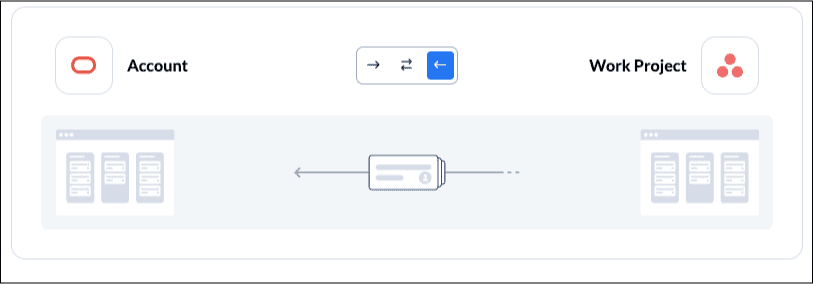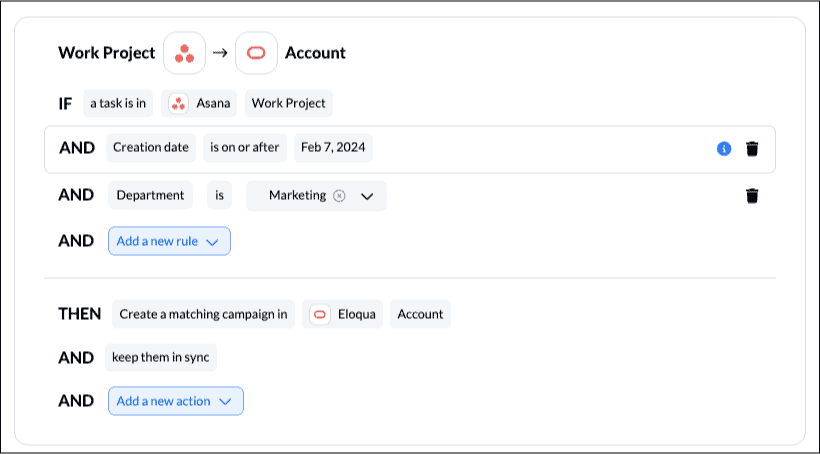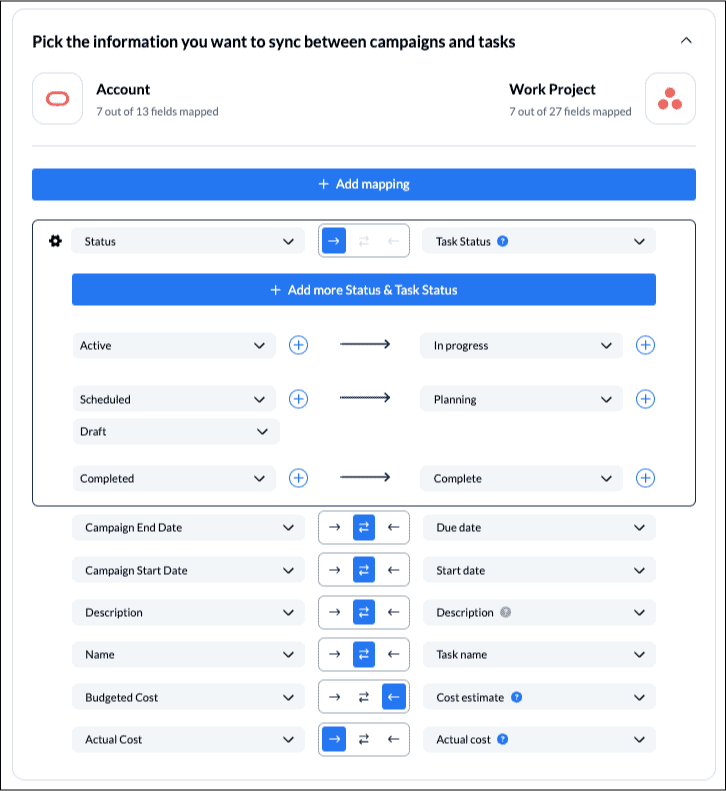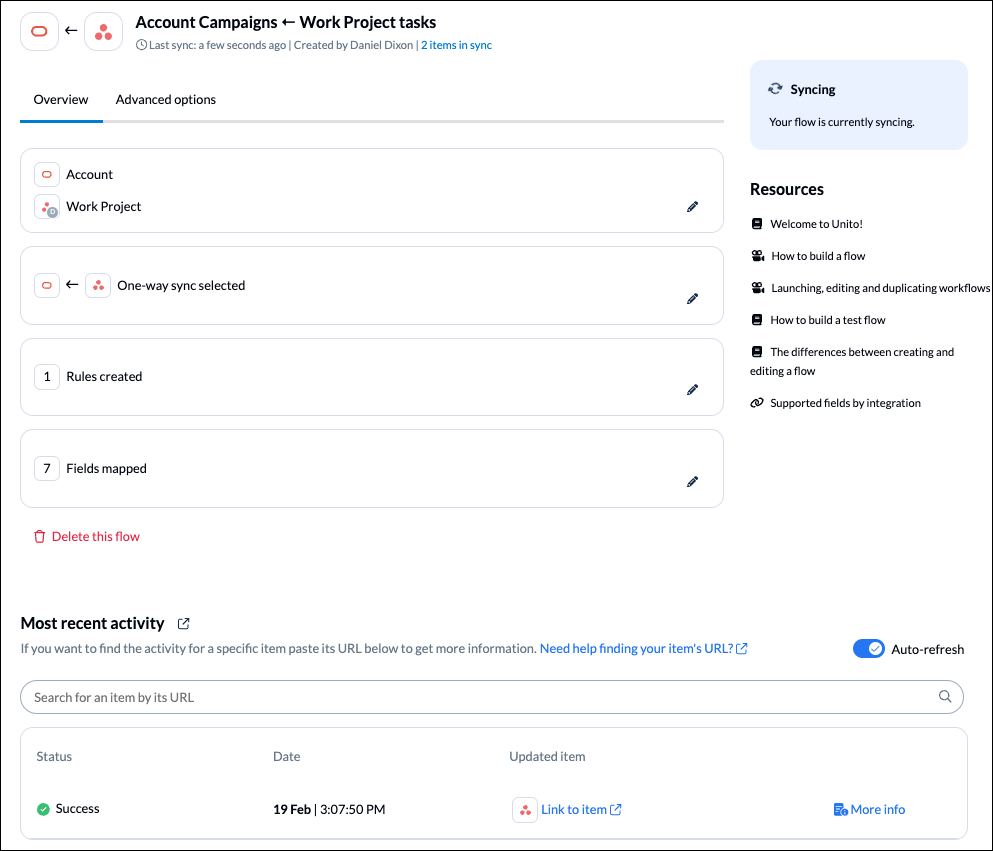How to Connect Asana to Eloqua with 2-Way Sync
Looking to connect Asana and Eloqua? This article explains how to fuse project management with marketing automation using Unito, shedding light on the collaboration benefits and actionable insights for your teams.
An estimated 92% of businesses* that use project management tools, such as Asana, meet their project objectives successfully. Meanwhile, Statista* reported in 2024 that 64% of marketers rely on Marketing Automation platforms, such as Eloqua, for email campaigns. Imagine the impact on efficiency if you were able to combine these two powerful platforms into a single unified workflow. Luckily, you’ve come to the right place for just such an integration with Unito’s 2-way sync platform. Below we’ll show you everything you need to know about connecting Asana tasks to Eloqua campaigns with real-time updates.
This is achievable through Unito’s 2-way integration for Asana and Eloqua which enables campaigns to be automatically created based on new or existing Asana tasks. Linking Eloqua campaigns to Asana tasks saves you from having to update teams in separate tools manually.
This 2-way Asana Eloqua integration is designed to automatically:
- Create campaigns in Eloqua based on specific Asana tasks including specific details (fields in Unito) chosen by the user.
- Sync Eloqua account data with Asana tasks in real-time so that manual changes in Asana or Eloqua update the other automatically.
TIP: In order to sync Eloqua campaigns with Unito, they must be deactivated and/or in draft mode.
In this guide:
- Tools: Asana and Eloqua
- Use cases: Task management, project reporting, data migration
- Great for: Data analysts, project managers, stakeholders and executives

About Unito’s 2-Way Integration for Asana and Eloqua
Unito’s 2-way sync integration platform enables a seamless, automated transfer of data between Asana and Eloqua, while ensuring top-notch security by incorporating features including:
- Certification under SOC 2 Type 2
- Data protection using HTTPS encryption
- Utilization of Amazon’s US AWS data centers for secure network infrastructure
- Implementation of threat detection systems
- Development of protocols for incident response
- OAuth2 authentication standards
- Single Sign-On (SSO) compatibility
Read more about Unito’s strict commitment to data security and privacy.
This platform also supports historical sync capabilities to ensure you gain an integrated view of projects including older entries. Unito provides a sophisticated, yet accessible field configuration for Eloqua and Asana with flexible rules that can accommodate custom fields to empower you with precise control over how data syncs and fits with your workflow.
Before we sync Asana and Eloqua to Unito:
- Ensure you have an account in both Asana and Eloqua with the right permissions to access and modify information in each tool.
- (Optional): Read about Unito’s Asana and Eloqua integrations to better understand the capabilities and limitations of each.
Step 1. Add Asana and Eloqua to Unito
- Navigate to the Unito App and select +Create Flow.
- Select Start Here to add Asana and Eloqua to Unito.
- Choose the accounts and work items (campaigns, emails, tasks) you want to connect.

When you’re ready, click Confirm.
Step 2. Set a flow direction from Asana to Eloqua
Flow direction tells Unito where to create and sync new campaigns or tasks.

In this case, Unito will create Eloqua campaigns based on certain Asana tasks that fit our rules in step 3. In step 4, we’ll decide which fields should sync 1-way or 2-way.
Click Confirm when you’ve chosen a flow direction.
Step 3. Set rules to sync specific Asana tasks with Eloqua
Your rules determine which tasks should become Eloqua campaigns. This is our chance to filter out unrelated tasks from our flow and only sync relevant tasks to Eloqua.
Select Add a new trigger to set additional conditions that specify the information you want included in the flow. We recommend using single-select fields (status, labels, a custom field, etc.) in Asana to filter specific tasks.

In this example, we’ve chosen to only sync tasks from our marketing department (a custom field we set up in Asana).
Find out more about setting rules.
Step 4. Pick fields to link between Eloqua and Asana
In this step you’ll determine the relationship between fields in Asana and Eloqua. You can also determine how automated updates occur at this stage: from one tool to another, or bidirectionally (2-way sync).
With a 2-way sync between fields, changes in either Asana or Eloqua will update the other. If you choose a one-way sync between a pair of fields, then only the source tool will update the destination, but not vice versa.
Choose + Add mapping to add a pair of fields in Asana and Eloqua. Then, Select a field for each tool and find the field you wish to map.

Click Confirm when you’re satisfied with your field mappings to proceed.
Find out more about setting field mappings.
Step 5. Save, close and launch your Asana to Eloqua flow
And that’s it! You’ve just completed the first flow between Asana and Eloqua. Congratulations!
If you’ve followed the steps above, your flow will now:
- Create an campaign in Eloqua for every Asana task you’ve included in the rule set.
- Sync dates, times, guests, campaign titles and descriptions between your tools and keep them up to date in real-time.
Monitoring Sync Progress
After completing the integration setup with Unito, you can start the data flow and choose Auto Sync for continuous synchronization. This sends new work items or records between tools without manual input.

The dashboard displays:
This allows you to quickly identify and address any issues.
Ready to optimize your projects?
Meet with our team to see what Unito can do for your workflows.
What’s next after connecting Eloqua to Asana?
- Duplicate this flow to suit other use cases you may have in mind.
- Now that you’ve got the hang of Unito, you can try something more complex, such as uniting technical and non-technical teams by syncing Asana to Jira, GitHub or Bitbucket.
- Get support on HubSpot deals by assigning tasks to Asana users or loop teams into your Intercom conversations.
- Generate progress reports based on real-time data by syncing Asana to Google Sheets
- Delegate work to external freelancers in Trello from your internal Asana project
- Compare ServiceNow and Salesforce.
Tips for Maximizing Your Asana Eloqua Integration
To fully leverage Unito’s Asana Eloqua integration, be sure to consistently check and refresh your configuration to make sure your flow functions as intended. If you plan on sharing access to the Unito interface, you’ll also want to thoroughly educate your team about the features of the integration.
Personalize your Eloqua Asana integration
With Unito, users have the ability to adjust their sync configurations in numerous ways including:
- Aligning specific details of an Asana task with corresponding synced fields in Eloqua.
- Designating particular fields for either uni-directional or bi-directional syncing.
- Triggering the generation of new tasks under certain triggers such as tags and assigned individuals.
- Enabling features like field mapping, synchronizing comments, custom field integration, and organizing work by hierarchy.
- Instituting guidelines for managing instances where data discrepancies occur.
- Choosing which pieces of campaign information from Eloqua are transferred back into Asana.
Thanks to Unito’s 2-way sync technology, updates happen instantaneously across both platforms ensuring consistent data without having to rely on other automated procedures.
Troubleshooting Common Issues
Even the most seamless integrations sometimes face hiccups. Unito’s error handling mechanisms act as a dedicated support team, ready to alert you about issues and provide immediate solutions. Common integration challenges—such as connection errors, creating criteria mismatches, and user permission obstacles—are met with Unito’s step-by-step guidance to get you back on track.
For those moments when you need a helping hand, Unito’s support channels offer direct assistance. Whether you’re navigating through flow statuses or resolving errors, Unito’s team is like your personal integration navigator, ensuring you reach your destination without detours.
Here’s a list of several troubleshooting guides you may find helpful:
- Common connection and sync issues in Unito
- Shared connector errors in Unito
- Unreachable domain error
- A technical overview of Unito’s Asana integration
- More about Unito’s Eloqua integration
Why build an Eloqua Asana Integration?
Integrating Asana with Eloqua presents multiple benefits, including enhanced collaboration among team members, streamlining of marketing workflows, and leveraging data for informed strategic planning decisions.
Integration helps in streamlining workflows, eliminating disjoint, and increasing overall productivity. Data from Eloqua marketing campaigns, when sent directly to Asana, can help manage marketing tasks effectively. Whether it’s acting upon new leads, customer research, or processing feedback, Asana can maneuver the derived information in an organized and actionable manner. On the flip side, Asana’s process updates can be looped back into Eloqua’s system to refine marketing tactics.

Upon merging the capabilities of these platforms, teams can accomplish the following:
- Improve coordination on marketing initiatives,
- Minimize manual workloads,
- Integrate data from both systems to guide strategy choices,
- Develop efficient and impactful marketing campaigns.
Boost Team Collaboration
The fusion of Asana and Eloqua fosters enhanced transparency and collaboration in teams from diverse departments. It provides a centralized location where project information and marketing data can be accessed, fostering an environment of open communication and collaboration. This increased transparency not only promotes team growth but also enhances cross-functional team efficiency by offering a shared platform for diverse expertise towards achieving common organizational goals.
Moreover, this integration offers:
- A clear roadmap for marketing campaign management
- Defining responsibilities and aligning stakeholders
- Support for leadership in setting goals and fostering collaborative processes
- Reinforcing team cohesion
- Access to Asana Stories via integration enables teams to track progress, interactions, and challenges
- Improved efficiency and satisfaction
Streamline Marketing Processes

Through the integration of Asana with Eloqua, marketing teams can streamline their workflows by automating mundane tasks. This not only reduces manual work, but also enables them to focus on more strategic aspects of their role. The benefit is compounded as this combination aligns marketing calendars and project timelines for a smoother planning process and effective campaign execution.
Enhance Data Insights
Combining these powerful tools can boost campaign outcomes by feeding new insights into both marketing automation processes and business intelligence dashboards, thereby strengthening your overall market presence.
When you bring together asana data with Eloqua’s Insight Analyzer, several advantages emerge:
- The ability to perform advanced analytics for a more complete grasp on how well marketing initiatives are performing
- Increased transparency regarding the effectiveness and objectives of various marketing campaigns
- Broad overviews on projects that are in line with wider company goals
- The opportunity to craft strategies based on solid data, which are instrumental in fostering growth
Seamless Data Syncing
Unito’s integration provides both immediate and retrospective data synchronization capabilities.
- Changes made in Asana or Eloqua are instantly updated to maintain real-time accuracy.
- It also brings in existing historical data for a comprehensive view of the project timeline.
- A wide range of Asana elements, including task names, assignees, due dates, descriptions, tags, and custom fields can be harmonized with Eloqua ensuring detailed management of tasks and their subsidiary components.
Through Unito’s robust bidirectional workflows, work items can seamlessly flow between Eloqua and Asana based on customizable parameters set by the user. This level of personalization grants users superior control over their workflow management while promoting consistent precision within the shared data sets. It is important to recognize that despite its versatility, there are certain constraints such as not being able to align approval statuses or followers related to a task across platforms. Its operability varies depending upon different tiers offered through Asana subscriptions.
Customizable Workflows

Unito’s integration stands out for its ability to create highly tailored workflows. It empowers users with the flexibility to establish rules that dictate the specific details of how information is transferred and integrated between Asana and Eloqua. The depth of customization extends to which data fields are synchronized, encompassing elements like:
- tags
- assignees
- comments
- custom fields
This adaptability enables users to refine their workflow systems in a manner that best serves their operational requirements.
Unito provides an option for designating a default section within Asana where newly formed tasks will be placed automatically, while also ensuring synchronization encompasses various Asana components such as subtasks. This functionality helps maintain organized work processes and supports well-defined project hierarchy even amidst complex project environments.
Real-World Use Cases for Asana Eloqua Integration
Integration of Asana with Eloqua is utilized across a wide range of practical applications. This includes orchestrating marketing campaigns, enhancing collaboration between different teams and departments, and executing reporting as well as analytics tasks.
To examine these applications more closely, we will explore the use cases in greater depth.
Marketing Campaign Management

Integrating Asana’s project management capabilities with Eloqua’s marketing automation platform significantly enhances the effectiveness of managing marketing campaigns. This collaboration enables teams to improve campaign planning through the visualization of schedules, monitoring task interdependencies, and efficiently handling deadlines. Such a synchronized approach guarantees timely execution of all marketing initiatives in harmony with an overarching strategy.
This integration brings added advantages by:
- Maintaining uniformity in messaging throughout various campaigns to match the corporate brand image.
- Making content development easier by optimizing processes for reviewing drafts and obtaining approvals.
- Establishing clear-cut roles and duties during every phase of creating content.
Cross-Functional Collaboration
The integration of Asana and Eloqua streamlines the process of managing cross-functional projects, significantly enhancing communication across different departments. This unified approach ensures that tasks are handled efficiently and all team members have a clear understanding of their roles within marketing campaigns.
By linking Asana with Eloqua, there is an opportunity to improve collaboration between marketing teams and both technical as well as non-technical groups. Teams can achieve this enhanced interaction by connecting Asana with platforms such as Jira, GitHub or Bitbucket for development-related activities while integrating support elements like HubSpot deals or Intercom conversations into the workflow.
Reporting and Analytics
The combination of Asana with Eloqua in the Oracle Cloud framework enriches project management and operational activities by providing a broader perspective. This integration fosters an organizational environment that leverages improved tagging and tracking capabilities, drawing more precise insights from data housed within the oracle database.
Stitch’s ETL services can capitalize on this synergy between Asana and Eloqua to streamline copying data into storage via etl pipelines, thus facilitating developers and company users to manage data effortlessly. Accuracy and timeliness of your information are maintained through these processes, equipping you with reliable intel for strategic business choices. The feature to export data amplifies your capacity to govern your organization’s informational assets effectively.
Key Takeaways
- Integrating Asana with Eloqua improves team collaboration, simplifies marketing processes through automation, and provides valuable data insights for strategic planning and decision-making.
- Unito’s 2-way integration platform facilitates real-time and historical data syncing between Asana and Eloqua, with deep field configuration and customizable workflows to ensure data security and meet specific user needs.
- Practical use cases of Asana and Eloqua integration include streamlined marketing campaign management, enhanced cross-functional collaboration, and more effective reporting and analytics within the Oracle Cloud ecosystem.
Frequently Asked Questions
What is Eloqua used for?
Marketing automation platform Eloqua facilitates the strategizing, development, and execution of campaigns through a variety of channels including email, display search ads, websites, video content, and mobile platforms. It streamlines marketing operations and aids in generating sales leads effectively.
Is Eloqua a CRM?
Eloqua itself is not a CRM. It has the capability to integrate with various CRM tools like Oracle’s CRM, SalesForce, or Microsoft Dynamics. This integration improves lead management and amplifies chances for customer conversions.
What is the difference between Eloqua and Marketo?
Eloqua distinguishes itself by excelling in sophisticated B2B marketing tactics and offering adaptable reporting options, while Marketo stands out for its ease of use and wide-ranging integration capabilities.
It’s imperative to weigh your specific business requirements and financial constraints when deciding which platform to adopt.
Can Eloqua integrate with Salesforce?
Certainly, Eloqua is capable of synchronizing with Salesforce using its inherent CRM connectors. By enabling this integration, it facilitates smooth linkages between sales and marketing operations, which enhances coordination and boosts return on investment.
How do you integrate with Eloqua?
To establish an integration with Eloqua, first access your Uberflip account and choose a Hub. Then navigate to the Integrations section where you’ll be prompted to input your Eloqua account details.
Once completed, this will enable you to link assets from Oracle Content Management directly with Eloqua.
Eloqua Asana Integration Benefits
Eloqua and Asana, when integrated, boost business productivity through
- Improved project management
- Increased collaboration efforts within teams
- Optimized marketing automation processes
Improved Project Management
One of the critical areas where Eloqua Asana integration adds tremendous value is in project management. Seamlessly managing workflows, organizing tasks, and efficiently tracking projects to completion becomes a breeze.
Enhanced Team Collaboration
Higher levels of team collaboration is another compelling advantage. This combination of premium tools facilitates smoother information flow, coordination, and team alignment. This improved collaboration leads to efficient project completion, fostering a more harmonious work environment for all team members.
Streamlined Marketing Automation
Streamlining is an essential component of business operations, particularly marketing automation. An Eloqua Asana integration offers a seamless blend of marketing interventions and project management, enhancing the proficiency of marketing tasks and attracting and retaining customers more effectively.
How Eloqua Asana Integration Enhances Task Management
When you integrate the heavyweight CRM platform Eloqua with the meticulous task manager Asana, it’s like merging a well-oiled machine with a super-efficient scheduler. You end up with a blend of precision and performance that revolutionizes your task management. Picture it this way – Eloqua provides the essential data, and Asana neatly organizes it into easily manageable units
That’s not all. The integration makes the task-tracking process simpler and efficient. Each interaction with a lead can be registered as a task in Asana, with relevant information from Eloqua automatically filled in. This eliminates the need for redundant data entry, reducing the scope for errors.
Using Eloqua Asana Integration for Better Team Collaboration
For teams working together, an Eloqua Asana integration offers several benefits:
- By organizing tasks and data in one place, it becomes easier for teams to collaborate, and it boosts business communication.
- Customer data from Eloqua can be connected to project timelines and tasks in Asana, allowing marketing, sales, and support teams to stay aligned with each other.
Leveraging Eloqua Asana Integration for Marketing Automation
Efficient marketing automation has become almost synonymous with Eloqua. But, when paired with Asana, it reaches another level. For instance, tasks related to customer communication can be automated, ensuring timely engagement and follow-ups.
More so, the completion of tasks in Asana can trigger new actions in Eloqua. For example, the closure of a customer support ticket in Asana could automatically ping the marketing team in Eloqua to reach out with a satisfaction survey. This seamless interplay between the two platforms amplifies the effectiveness of marketing automation.


